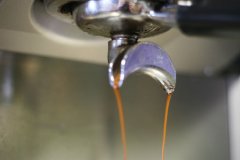What is Espresso?
Espresso was born in 1946, and Gaggia further improved the piston pressure system-using spring pressure instead of manual pressing-to float a golden layer of coffee fat on brewed coffee-Cream Klima, the first appearance of Cream Clema in coffee history, and this year became the official birth year of Espresso. Gaggia officially established the coffee machine factory in 1948. The mass-produced Gaggia coffee machine was sought after by the major coffee shops in Italy at that time, which accelerated the popularity of Espresso in Italy, Spain, Portugal and other southern European countries. But it wasn't until around 1986 that Espresso was introduced around the world by Starbucks. Since then, people in the coffee industry around the world began to know and understand this kind of coffee. It was only about a decade earlier than the Chinese people came into contact with espresso. So the more popular and reasonable way to name it is espresso.
Now "Espresso" has almost become a representative symbol of Italy, so it seems more natural for Italy to define "Espresso".
So what is "Espresso"? Comprehensive coffee beans roasted at a depth of 7-8 grams are ground into very fine coffee powder. after 9 atmospheric pressure and high temperature hot water of about 92 degrees Celsius, 30 milliliters of strong coffee liquid is rapidly extracted in a short time of 15 seconds called "Espresso". The most important thing about a successful "Espresso" is to see if there is a thick layer of brown-red grease foam floating on the surface: "Crema Cleima".
The most important feature of "Espresso" is the cohesion of fragrance and taste. The general orthodox way to drink is to drink it in one sip while waiting for the coffee to come out. While enjoying the fragrant taste, caffeine intake is greatly reduced. This drinking method, which takes the taste of coffee to the extreme but takes care of health, has made coffee experts around the world recognize that "Espresso" is worthy of the soul of coffee.
Espresso is Italian, meaning "under pressure", which reflects the importance of stress in the production of espresso. In the eyes of those who play with coffee, Espresso is no longer a simple "espresso". It is a kind of comprehensive coffee, a method of roasting, a kind of coffee brewing, a kind of cooking, but also a kind of life.
In Italy, Espresso is simply a local life concerto. In the morning, drink a latte (Latte); then, people like to drink Espresso in the store, everyone waits in front of the bar, and after getting the first-hand coffee, they drink it in three sips. The guests in the shop knew each other and talked to each other, and even the coffee maker (Barista) took part in the chat, so the cafe became a social place.
In the United States and Taiwan, Italian-style cafes are littered with places for young people to date and chat. Most of them don't drink Espresso, only cappuccino or latte with milk. Most of these young people don't know the delicacy of Espresso. They just come here to see the atmosphere of Espresso. Presumably, this is also a kind of Espresso life!
The warm hue of foam, the strong and wonderful fragrance, the soft and smooth liquid like velvet, and the strong and persistent taste, all of which are presented in a well-brewed cup of espresso coffee, provide the drinker with the pleasure of smell, taste and vision. Only hearing is excluded from this multi-sensory experience. Between the complex chemical composition of coffee and its multiple sensory systems, a connection is created by sipping this small cup of coffee.
Why is this issue named "Italian extract"? I think the most enjoyable and mysterious thing about every cup of espresso is at the moment of its extraction.
Coffee also blooms its own beauty on the tip of the tongue, as well as the thick culture. I hope all of us will become walkers to spread the beautiful culture. The pictures are not easy, they are all moved outside the wall, we appreciate them slowly, hold back our saliva, and slowly experience the flowing liquid gold.
Important Notice :
前街咖啡 FrontStreet Coffee has moved to new addredd:
FrontStreet Coffee Address: 315,Donghua East Road,GuangZhou
Tel:020 38364473
Related
- Beginners will see the "Coffee pull flower" guide!
- What is the difference between ice blog purified milk and ordinary milk coffee?
- Why is the Philippines the largest producer of crops in Liberia?
- For coffee extraction, should the fine powder be retained?
- How does extracted espresso fill pressed powder? How much strength does it take to press the powder?
- How to make jasmine cold extract coffee? Is the jasmine + latte good?
- Will this little toy really make the coffee taste better? How does Lily Drip affect coffee extraction?
- Will the action of slapping the filter cup also affect coffee extraction?
- What's the difference between powder-to-water ratio and powder-to-liquid ratio?
- What is the Ethiopian local species? What does it have to do with Heirloom native species?



